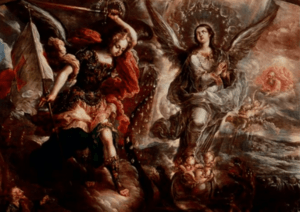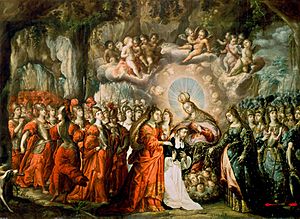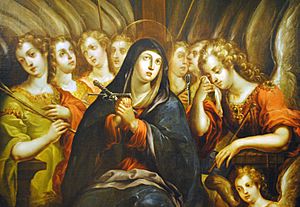Cristóbal de Villalpando facts for kids
Cristóbal de Villalpando (born around 1649 – died August 20, 1714) was a famous artist from New Spain (which is now Mexico). He was known for his amazing Baroque style paintings. This art style uses lots of drama, rich colors, and grand scenes.
Villalpando was a Criollo, meaning he was of Spanish descent but born in the Americas. He was also an important arts manager and even a captain in the guard. He painted many beautiful works that you can still see today. Many of his paintings are in cathedrals in Mexico, like those in Querétaro and Mexico City. One of his famous works shows the Zócalo (the main square) in Mexico City. It even shows damage from a riot that happened in 1692.
Contents
Life of Cristóbal de Villalpando
Cristóbal de Villalpando was born in Mexico City. His family was quite important. He started his career in the local army as an ensign, which is a junior officer. At the same time, he learned to paint. He studied with a well-known artist named Baltasar de Echave Rioja.
In 1669, Cristóbal married María de Mendoza. They had four children together. He became very busy with art, getting many requests to paint religious scenes. These commissions came from both Mexico City and Puebla. You can find some of his paintings in the sacristy of the Mexico City Metropolitan Cathedral. A sacristy is a room in a church where sacred items are kept.
Villalpando became a captain in the army. In 1686, he was chosen as one of the three leaders of the painters' guild in Mexico. A guild was like a club or union for artists. He served as a director (called a veedor) several times.
He even included himself in one of his paintings! In his work Apparition of Saint Michael on Mount Gargano, you can find his self-portrait. He painted himself among the clergy (church leaders) at the bottom right of the painting.
Cristóbal de Villalpando passed away in Mexico City in 1714. He was buried there.
Villalpando's Painting Style

When Villalpando first started painting, his art showed the influence of a famous European artist named Peter Paul Rubens. Rubens was known for his vivid colors and strong figures.
As Villalpando grew as an artist, his style changed. He moved away from extremely bright colors and very strong figures. Instead, he used a wider range of colors. He also started to include more traditions from the "New World" (the Americas) in his art.
In his later works, Villalpando used light differently. He created more contrast in his paintings. He would even add artificial light sources within his art. This made his paintings feel more dramatic and exciting. Many other artists tried to paint like him because his style was so admired.
Villalpando was also very skilled at changing his style. He would adapt his painting technique to fit the artwork and the person who asked for it. Sometimes he used rough, quick brushstrokes. Other times, he used very careful and detailed strokes.
Famous Works by Villalpando
Some of Villalpando's first important paintings were for the Puebla Cathedral. These include a large painting called The Transfiguration. He also painted the Assumption of the Virgin inside the dome of the apse chapel. These works often included themes about the eucharist, which is a Christian ceremony.
One of his very large altar pieces is called Moses and the Brazen Serpent and the Transfiguration of Jesus (painted in 1683). This huge painting from the Puebla cathedral was recently shown in major art exhibits. It was displayed in Mexico City and at the Metropolitan Museum of Art in New York.
For the sacristy of the Mexico City Metropolitan Cathedral, he painted several important works:
- The Church Militant and the Church Triumphant
- The Triumph of Religion
- The Virgin of the Apocalypse
- Our Lady of Sorrows
- The Apparition of Saint Michael Archangel
Sadly, many of Villalpando's portraits have been lost over time. Some of his religious paintings are also missing. However, one of his amazing religious masterpieces was recently found. This painting, called The Adoration of the Magi (from 1683), was discovered hanging in the president's office at Fordham University. It was then featured in a special Villalpando art show at the Metropolitan Museum of Art in 2017.
View of the Zócalo of Mexico City (1695)
Villalpando's painting of the main square of Mexico City is very important. It doesn't just show the big buildings and features around the square. These include the Metropolitan Cathedral, the viceroy's palace, the archbishop's palace, and the town council building. It also shows the busy market area called the Parían Market.
What makes this painting truly special is that it shows the everyday life of people in Mexico City. You can see residents of all backgrounds and social classes. An important historical detail in the painting is the damage to the viceroy's palace. This damage was caused by a riot that happened in June 1692.
The viceroy of Mexico, Don Gaspar de Sandoval Silva y Mendoza, asked Villalpando to paint this scene. The viceroy was about to return to Spain after a challenging time in charge. He might have wanted the painting as a souvenir of his time as viceroy. It's interesting that Villalpando chose to paint the damaged palace. He didn't try to hide this important historical event.
The painting shows that the main square had returned to its normal busy state. You can see wealthy people arriving in carriages. There are also many shops filled with goods. Plus, there are lots of Indigenous and mixed-race market sellers. The painting suggests a sense of harmony and success. It almost makes you forget about the damaged palace.
This painting is now part of a private collection in the United Kingdom. It has been used as the cover for two important books about colonial Spanish America.
Gallery
See also
 In Spanish: Cristóbal de Villalpando para niños
In Spanish: Cristóbal de Villalpando para niños
- Mexican art
- Miguel Cabrera (painter)
- Juan Correa
- Churrigueresque
- Juan Rodríguez Juárez



















